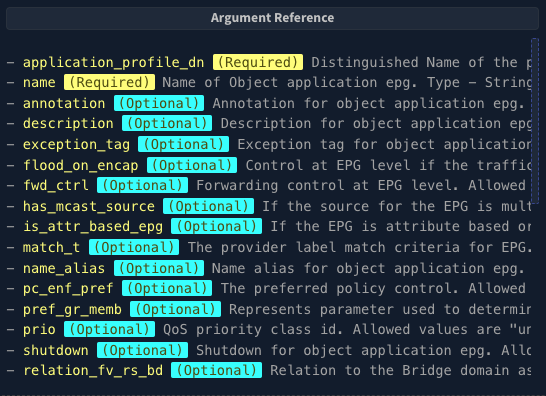Configure Resources
ACIOps requires that terraform server and its parameters be setup before ACIOps can deploy configurations on your Cisco ACI Fabric.
“ACI as Code” is a methodology for managing Cisco ACI (Application Centric Infrastructure) through infrastructure-as-code (IaC) practices. Instead of configuring network components manually via the Cisco ACI APIC interface, network administrators use code to define, automate, and manage their ACI configurations. This code-based approach brings modern software development practices to network management, making it easier to achieve automation, consistency, and scalability within ACI deployments.
Here’s what ACI as Code enables:
-
- Declarative Configuration: Using code to describe the desired state of network policies, tenants, application profiles, contracts, and other ACI objects, so configurations are both consistent and predictable.
-
- Automation and Orchestration: By leveraging IaC tools like Terraform, configurations can be automatically deployed or updated across environments, reducing manual errors and speeding up deployment times.
-
- Version Control and Collaboration: Storing ACI configurations in repositories like Git allows teams to track changes, manage versions, and collaborate on infrastructure, creating a more controlled, transparent, and auditable change process.
-
- Scalability and Consistency: Code-based configuration can be reused across multiple environments, allowing administrators to scale network configurations or replicate environments without the risk of configuration drift.
-
- Continuous Integration (CI) and Continuous Deployment (CD): ACI as Code can be integrated into CI/CD pipelines, allowing network changes to go through testing and validation processes similar to application code before deployment.
ACIOps implements ACI as Code with Terraform without the need know how terraform works or build knowledge on Terraform.
This was done by developing a user interface that builds Terraform resource config,
implements Terraform plan and applies the configuration to the infrastructure with Terraform apply.
Terraform plan previews the changes Terraform will make to infrastructure based on the current configuration,
showing what will be added, changed, or destroyed before applying.
ACIOps ACI as Code User Interface
Resource Selection
You select the resources that you would like to configure from the dropdown. The cateories and resources under each category is documented on Cisco ACI Terraform Provider documentation.

On selection of a resource, a graph is displayed. The graph
indicates the selected resource and any other resources that are directly related to the selected resource. In the diagram below,
the aci_application_epg has a relationship with the aci_application_profile and the aci_bridge_domain. In most cases, those
resources will need to exist before the selected resource could be created.
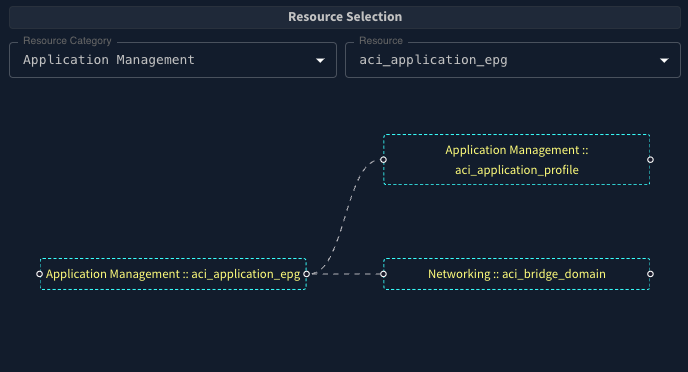
Resource Configuration
When a resource is selected, the resource configuration section becomes populated with the configuration interface for the selected resources.

Some of the parameters data type could be strings, DNs, integers, etc. Depending on the parameter, you should select the data type.
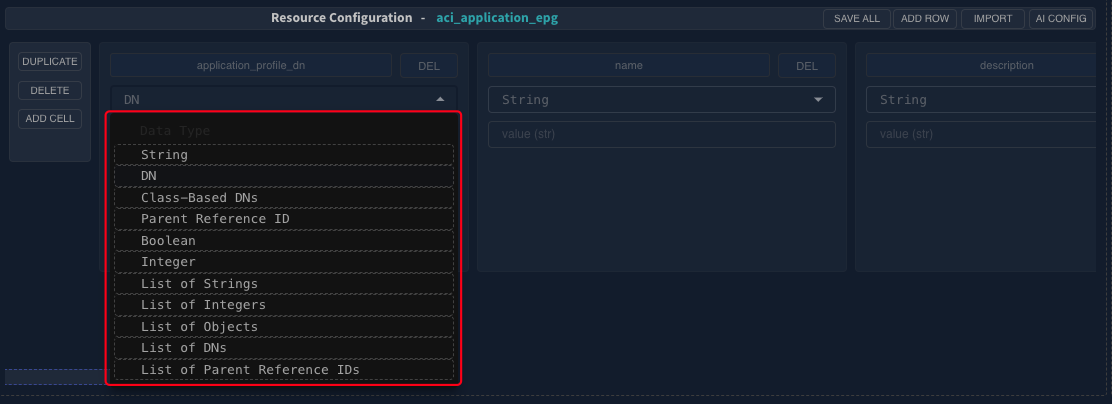
Data Types Could be any of the following:
- String: If the parameter requires a string, e.g. a Name.
- DN: If the parameter requires a DN and the DN is related to the resource. For example, the aci_application_epg resource requires the DN of the application profile and the bridge domain. Both options would be present when a DN is specified and all the current DNs for each of both the application profile and the bridge domains on the fabric will be in the dropdown as shown below.
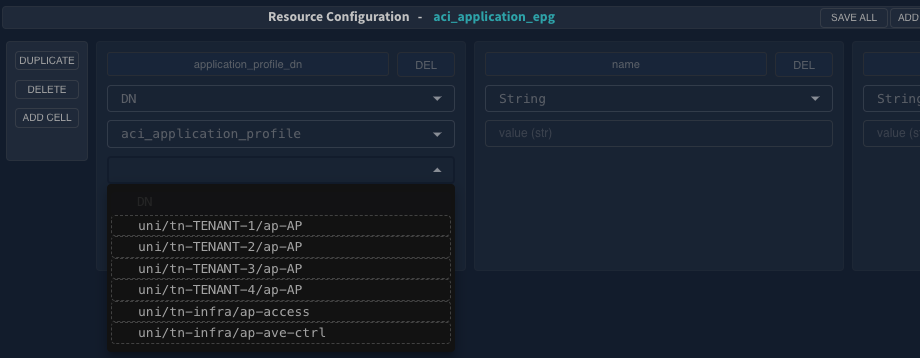
- Class-Based DNs:
This is useful in cases where the DNs are not present. Instead, you’d specify the class and
ACIOps will retrieve all the DNs in that class. In the example below, the
fvApclass was specified and it retrieved all the DNs for the class.
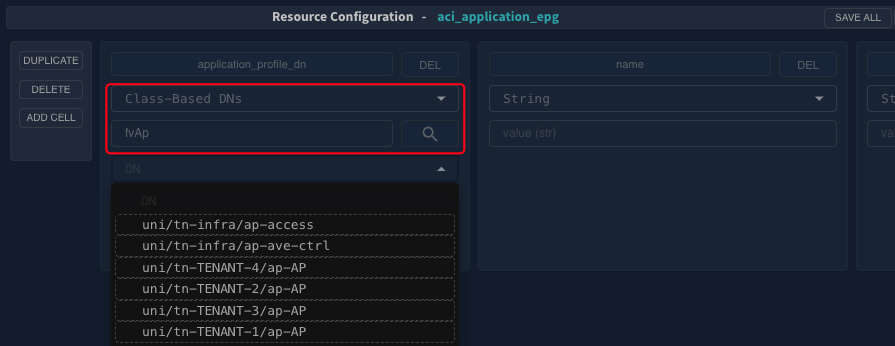
- Parent Reference ID: If you decide to create an application_epg, the application_profile must current exist on the infrastructure. However, if you intend to create the application_profile and the application_epg at the same time, you will need to associate the application_epg to the application_profile. This is done by associating the application_epg to the application_profile’s ID. In the example below, I have created an application_profile called custom-ap and an ID was automatically generated as shown in the image below.

Next, I create an application_epg and if i indicate that I would like to associate it with the previously created application_profile by selecting the Parent Reference ID, the
ID of the recently created application_profile would be available to build the application_epg to application_profile association.

The resulting output would be that the application_epg is associated to the application_profile

- Boolean: If the data type requires a
trueorfalse. - Integer: If the data types requires a
Number.
The other data types are made of up a combination of all the data types specified above.
Configurations

-
Saved: This is the list of recently created configurations on ACIOps but has not been commited to the database. This is stored in your browser and would be lost if the brower is refresh.
-
History: This is a list of configurations that have been commited to the database or pushed to the Fabric.
-
Archive: After a configuration has been pushed to the fabric, you could decide to archive the configuration so it does not clutter the UI.
-
Templates: This is the list of configurations that have been converted to templates.
-
View All: This is used to retrieve configurations that has been pushed via Terraform to the fabric. This configuration is stored in the terraform statefile and is retrieved from the statefile.
Argument Reference
The Argument Reference is a section that describes the specific arguments, parameters, or properties you can set within a particular resource. Each argument controls some aspect of the configuration, and this section details what each argument does, its data type, default values (if any), and whether it is required or optional.
The Argument Reference helps you understand how to configure the resource by showing exactly which inputs are available and explaining the effects and constraints of each. This reference is essential for properly defining the infrastructure and ensuring that it aligns with both the provider’s capabilities and the user’s requirements. The image below shows the argument reference for the application_epg.
